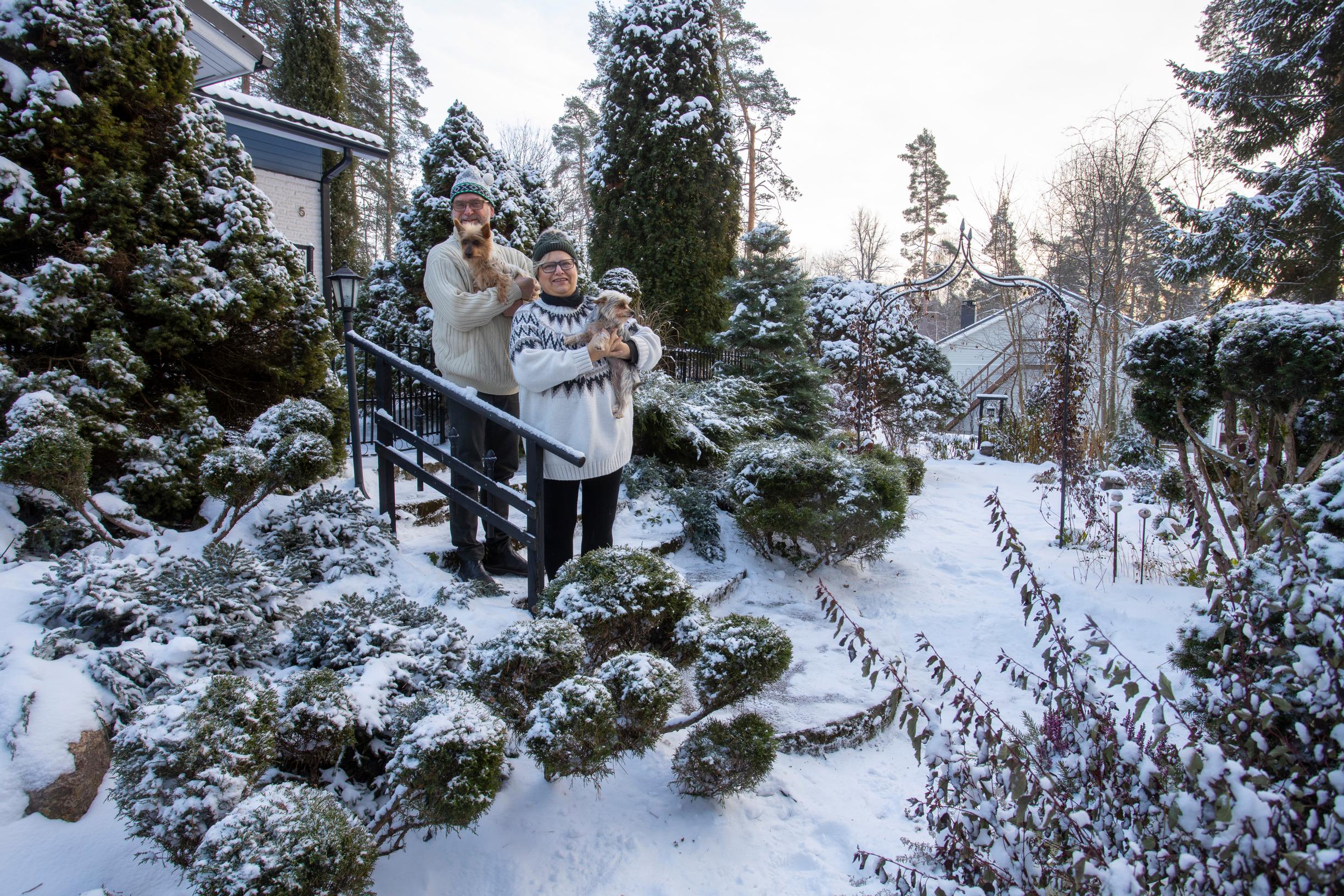
Conifers steal the show: Nina and Lasse’s garden stuns even in winter
In Nina and Lasse Rihu’s garden, the striking forms of conifers stand out in a particularly special way during winter when everything else is bare. Some conifers have naturally grown into cones, spheres, or columns, while others have been shaped by Nina’s skillful hands.
Nina and Lasse Rihu’s garden in Kymenlaakso, Finland, has undergone a transformation during the cold night as soft, powdery snow has blanketed the dark ground. Numerous conifers appear as if they’ve been generously dusted with powdered sugar. The early December sun, low in the sky, accentuates their shapes even more. A solitary aster, still blooming in the winter landscape, seems like it’s in the wrong painting.
Luckily, the freshly fallen first snow is light and airy, so it doesn’t harm the woody plants. If heavier snow had fallen, Nina would already be busy touring the garden with a brush.
“It’s quick work when I whisk the snow off the trees and shrubs so they don’t split or break. Clumpy snow is especially bad.”
Garden: Nina and Lasse’s garden in Pilkanmaa, Kouvola, Finland
Size: 1,150 m²
Soil: Old forest ground improved with plenty of clay and soil
Special features: The conifer-dominant garden remains decorative even in its winter attire.






Conifers—junipers, thujas, firs, pines, and various spruces—are dear to Nina and Lasse. The oldest of them, the magnificent dwarf white spruces, have been growing on the property since the late 1980s. Nina planted them almost immediately after the family’s new home was completed. For a long time, she worried that the slow-growing seedlings, only a few dozen centimeters tall, would be trampled during their three sons’ roughhousing.
“I probably reminded them ad nauseam that they needed to be careful,” she laughs.
“At first, our dwarf white spruces didn’t look like much, but nowadays they are an important part of the garden’s appearance,” Lasse says.






Although conifers have been the garden’s main plants from the beginning, Nina and Lasse admit they didn’t initially consider all their benefits, such as providing greenery to the garden even in winter when other colors have faded. They also didn’t realize that the distinctive shapes of conifers stand out in a very special way when everything else is bare.
In addition to the dwarf white spruces, many other conifers in the garden have naturally grown into sleek cones, spheres, or columns. Some, however, have acquired their current appearance under Nina’s skillful hands. With regular trimming, seedlings can become impressive single-stemmed focal points, but it requires time and skill. Nina says she worked on some topiary trees for years before they looked good to her eye because conifers can’t be pruned heavily all at once.








Generally speaking, the best time to prune conifers is in early spring before they start to grow, but exceptionally well-pruned thujas, junipers, and yews can be shaped at other times as well. Nina only prunes on cool, dry days when sap flow is minimal.
The shears also saved an old yew that the Rihus had received from Nina’s mother as a housewarming gift. The seedling had grown so large that its branches arched over the pathway. In winter, it had the annoying habit of dumping snow on Nina when she left for work early in the morning.
“Eventually, I got fed up and asked Lasse to prune the bush lower. Luckily, he didn’t cut it down because soon after I saw in a gardening magazine a ‘broccoli tree’—a yew whose branches had been pruned bare and the tops shaped into balls. Nowadays, I think the yew is beautiful even in winter.”
Nina has combined shrubs and perennials with the conifers, but in recent years she has gradually begun to reduce them. The aim is to leave growth space for the beloved conifers so that the carefully planned views of the garden don’t become overgrown. The species she will keep are those that look beautiful year-round. The dried flower heads of hydrangeas, the seed balls of clematis, globe thistles, and other upright perennials, as well as ornamental grasses, bring visual delight to the garden even in winter.


Interested in seeing what Nina and Lasse’s garden looks like in summer? Check out this story: A harmonious garden in Kouvola: stunning conifers and carefully chosen perennials [in Finnish]


Nina’s tips for a winter garden
1. Add color to the winter
Plant various coniferous trees and shrubs to bring color and abundance to the winter scenery. In other seasons, they can serve as a calm backdrop for more vibrant species.
2. Forget cleanup
Leave stiff-stemmed perennials and climbers as they are in the fall—they are delicately beautiful when frosty and dusted with snow.
3. Make room for branches
Make sure the branches of small deciduous trees stand out. A twisted filbert or a fringed Japanese larch are good options to plant in the best spots.
4. Lighten the load
Don’t let heavy snow damage the branches of woody plants. Regularly shake off the snow, especially from conifers.


